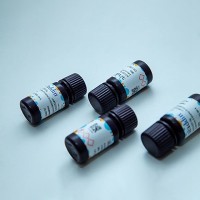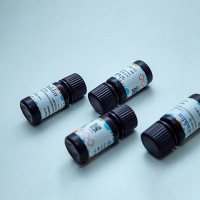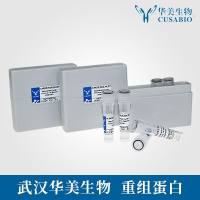Strep/FLAG Tandem Affinity Purification (SF‐TAP) to Study Protein Interactions
互联网
- Abstract
- Table of Contents
- Materials
- Figures
- Literature Cited
Abstract
In recent years, several methods have been developed to analyze protein?protein interactions under native conditions. One of them, tandem affinity purification (TAP), combines two affinity?purification steps to allow isolation of high?purity protein complexes. This unit presents a methodological workflow based on an SF?TAP tag comprising a doublet Strep?tag II and a FLAG moiety optimized for rapid as well as efficient tandem affinity purification of native proteins and protein complexes in higher eukaryotic cells. Depending on the stringency of purification conditions, SF?TAP allows both the isolation of a single tagged?fusion protein of interest and purification of protein complexes under native conditions. Curr. Protoc. Protein Sci. 57:19.20.1?19.20.19. © 2009 by John Wiley & Sons, Inc.
Keywords: SF?TAP; tandem affinity purification; protein complexes
Table of Contents
- Introduction
- Basic Protocol 1: Strep/Flag Tandem Affinity Purification (SF‐TAP) of Protein Complexes From HEK293 Cells
- Support Protocol 1: Generation of HEK293 Clones Stably Expressing SF‐TAP‐Tagged Proteins
- Support Protocol 2: Chloroform/Methanol Precipitation of Proteins
- Basic Protocol 2: In‐Solution Digest of Proteins for Mass Spectrometric Analysis
- Basic Protocol 3: Pre‐Fractionation Via SDS‐Page and In‐Gel Digestion Prior to LC‐MS/MS Analysis
- Support Protocol 3: Quick MS‐Compatible Colloidal Coomassie Stain of Proteins After SDS‐PAGE Separation
- Basic Protocol 4: LC‐MS/MS Analysis of Digested SF‐TAP Samples
- Support Protocol 4: Database Search and Data Analysis by Scaffold
- Reagents and Solutions
- Commentary
- Literature Cited
- Figures
Materials
Basic Protocol 1: Strep/Flag Tandem Affinity Purification (SF‐TAP) of Protein Complexes From HEK293 Cells
Materials
Support Protocol 1: Generation of HEK293 Clones Stably Expressing SF‐TAP‐Tagged Proteins
Materials
Support Protocol 2: Chloroform/Methanol Precipitation of Proteins
Materials
Basic Protocol 2: In‐Solution Digest of Proteins for Mass Spectrometric Analysis
Materials
Basic Protocol 3: Pre‐Fractionation Via SDS‐Page and In‐Gel Digestion Prior to LC‐MS/MS Analysis
Materials
Support Protocol 3: Quick MS‐Compatible Colloidal Coomassie Stain of Proteins After SDS‐PAGE Separation
Materials
Basic Protocol 4: LC‐MS/MS Analysis of Digested SF‐TAP Samples
Materials
Support Protocol 4: Database Search and Data Analysis by Scaffold
Materials
|
Figures
-
Figure 19.20.1 The Strep/FLAG tandem affinity purification. (A ) N‐ and C‐terminal SF‐TAP tags (POI, protein of interest). (B ) Overview of both purification steps. (1) Purification by the tandem Strep‐tag II moiety: binding to Strep‐Tactin matrix followed by elution with desthiobiotin. (2) Purification by the FLAG‐tag moiety: binding to anti‐FLAG M2 affinity matrix followed by elution with FLAG peptide. Abbreviations: sp., specific interactors (shown as gray circles); n.sp., nonspecific proteins (contaminants; shown as white circles). View Image -
Figure 19.20.2 Flow chart of a SF‐TAP approach including MS identification of copurified proteins. This figure connects all protocols presented in this unit. View Image -
Figure 19.20.3 Flow chart for the SF‐TAP procedure. View Image
Videos
Literature Cited
| Literature Cited | |
| Alberts, B. 1998. The cell as a collection of protein machines: Preparing the next generation of molecular biologists. Cell 92:291‐294. | |
| Berggard, T., Linse, S., and James, P. 2007. Methods for the detection and analysis of protein‐protein interactions. Proteomics 7:2833‐2842. | |
| Bouwmeester, T., Bauch, A., Ruffner, H., Angrand, P.‐O., Bergamini, G., Croughton, K., Cruciat, C., Eberhard, D., Gagneur, J., Ghidelli, S., Hopf, C., Huhse, B., Mangano, R., Michon, A.M., Schirle, M., Schlegl, J., Schwab, M., Stein, M.A., Bauer, A., Casari, G., Drewes, G., Gavin, A.C., Jackson, D.B., Joberty, G., Neubauer, G., Rick, J., Kuster, B., and Superti‐Furga, G. 2004. A physical and functional map of the human TNF‐alpha/NF‐kappa B signal transduction pathway. Nat. Cell Biol. 6:97‐105. | |
| Cline, M.S., Smoot, M., Cerami, E., Kuchinsky, A., Landys, N., Workman, C., Christmas, R., Avila‐Campilo, I., Creech, M., Gross, B., Hanspers, K., Isserlin, R., Kelley, R., Killcoyne, S., Lotia, S., Maere, S., Morris, J., Ono, K., Pavlovic, V., Pico, A.R., Vailaya, A., Wang, P.L., Adler, A., Conklin, B.R., Hood, L., Kuiper, M., Sander, C., Schmulevich, I., Schwikowski, B., Warner, G.J., Ideker, T., and Bader, G.D. 2007. Integration of biological networks and gene expression data using Cytoscape. Nat. Protoc. 2:2366‐2382. | |
| Collins, M.O. and Choudhary, J.S. 2008. Mapping multiprotein complexes by affinity purification and mass spectrometry. Curr. Opin. Biotechnol. 19:324‐330. | |
| Daulat, A.M., Maurice, P., Froment, C., Guillaume, J.L., Broussard, C., Monsarrat, B., Delagrange, P., and Jockers, R. 2007. Purification and identification of G protein‐coupled receptor protein complexes under native conditions. Mol. Cell. Proteomics 6:835‐844. | |
| Gavin, A.‐C., Bosche, M., Krause, R., Grandi, P., Marzioch, M., Bauer, A., Schultz, J., Rick, J.M., Michon, A.‐M., Cruciat, C.‐M., Remor, M., Höfert, C., Schelder, M., Brajenovic, M., Ruffner, H., Merino, A., Klein, K., Hudak, M., Dickson, D., Rudi, T., Gnau, V., Bauch, A., Bastuck, S., Huhse, B., Leutwein, C., Heurtier, M.A., Copley, R.R., Edelmann, A., Querfurth, E., Rybin, V., Drewes, G., Raida, M., Bouwmeester, T., Bork, P., Seraphin, B., Kuster, B., Neubauer, G., and Superti‐Furga, G. 2002. Functional organization of the yeast proteome by systematic analysis of protein complexes. Nature 415:141‐147. | |
| Gloeckner, C.J., Boldt, K., Schumacher, A., Roepman, R., and Ueffing, M. 2007. A novel tandem affinity purification strategy for the efficient isolation and characterization of native protein complexes. Proteomics 7:4228‐4234. | |
| Junttila, M.R., Saarinen, S., Schmidt, T., Kast, J., and Westermarck, J. 2005. Single‐step Strep‐tag purification for the isolation and identification of protein complexes from mammalian cells. Proteomics 5:1199‐1203. | |
| Kang, D., Gho, Y., Suh, M., and Kang, C. 2002. Highly sensitive and fast protein detection with Coomassie Brilliant Blue in sodium dodecyl sulfate–polyacrylamide gel electrophoresis. Bull. Korean Chem. Soc. 23:1511‐1512. | |
| Lee, J.W. and Lee, S.‐K. 2004. Mammalian two‐hybrid assay for detecting protein‐protein interactions in vivo. Methods Mol. Biol. 261:327‐336. | |
| Olsen, J.V., de Godoy, L.M., Li, G., Macek, B., Mortensen, P., Pesch, R., Makarov, A., Lange, O., Horning, S., and Mann, M. 2005. Parts per million mass accuracy on an Orbitrap mass spectrometer via lock mass injection into a C‐trap. Mol. Cell. Proteomics 4:2010‐2021. | |
| Rigaut, G., Shevchenko, A., Rutz, B., Wilm, M., Mann, M., and Seraphin, B. 1999. A generic protein purification method for protein complex characterization and proteome exploration. Nat. Biotechnol. 17:1030‐1032. | |
| Schmidt, T.G. and Skerra, A. 2007. The Strep‐tag system for one‐step purification and high‐affinity detection or capturing of proteins. Nat. Protoc. 2:1528‐1535. | |
| Skerra, A. and Schmidt, T.G. 2000. Use of the Strep‐Tag and streptavidin for detection and purification of recombinant proteins. Methods Enzymol. 326:271‐304. | |
| Vermeulen, M., Hubner, N.C., and Mann, M. 2008. High confidence determination of specific protein‐protein interactions using quantitative mass spectrometry. Curr. Opin. Biotechnol. 19:331‐337. | |
| Walhout, A.J., Temple, G.F., Brasch, M.A., Hartley, J.L., Lorson, M.A., van den Heuvel, S., and Vidal, M. 2000. GATEWAY recombinational cloning: Application to the cloning of large numbers of open reading frames or ORFeomes. Methods Enzymol. 328:575‐592. | |
| Wessel, D. and Flügge, U.I. 1984. A method for the quantitative recovery of protein in dilute solution in the presence of detergents and lipids. Anal. Biochem. 138:141‐143. | |
| Yu, Y.Q., Gilar, M., Lee, P.J., Bouvier, E.S., and Gebler, J.C. 2003. Enzyme‐friendly, mass spectrometry‐compatible surfactant for in‐solution enzymatic digestion of proteins. Anal. Chem. 75:6023‐6028. |







